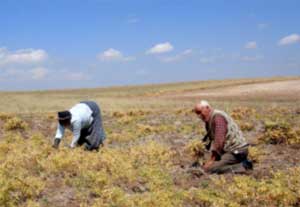Aleppo, Syria
August 22, 2007
A new kabuli chickpea variety,
Gokce, developed by the
International Center for Agricultural Research in the Dry Areas
(ICARDA), in collaboration with Turkish national scientists,
has withstood severe drought in Turkey and produced an
impressive yield in adverse weather conditions.
 |
|
Farmers harvesting
Gokce, a drought-tolerant variety of kabuli
chickpea, in Yozgat province of Central Anatolia
region in Turkey. The region has been hit by a
severe drought causing failure of crops.
|
|
Gokce is not only drought tolerant
but also has moderate tolerance to Ascochyta blight, a disease
that devastates chickpea crop. It has survived the acute drought
in the Central Anatolia region of Turkey that has wreaked havoc
for farmers. In most areas where wheat, barley, and other crops
have failed, Gokce’s yield is high.
Turkish newspapers have quoted the Turkish Union of Agricultural
Chambers (TZOB) as claiming that the loss from the drought is
estimated to be about 5 billion Turkish Lira or US$ 4 billion.
The government has allocated YTL 514 million (US$411 million)
for compensation to farmers.
However, farmers cultivating Gokce in the Central Anatolia
region say that the yield is expected to be around
one-and-a-half tons per hectare, while other crops have been
badly hit by the current drought.
“Work on developing this variety began in 1984/85 as part of an
international yield trial,” says
Dr R. S. Malhotra,
senior chickpea breeder at ICARDA. “Gokce was released for field
trials in Turkey in 1991.”
ICARDA, based in Aleppo, Syria, is a non-profit international
agricultural research center in a worldwide consortium of 15
centers, supported by the Consultative Group on International
Agricultural Research (CGIAR).
Based on the success of the field trials, the Exporters’ Union
Seed and Research Company (ITAS), a non-profit organization set
up by agricultural exporters of Turkey, introduced Gokce into
the country in 1997. “The results of field trials were excellent
and we got the variety registered,” says Ismail Kusmenoglu,
general manager of ITAS.
ITAS initiated an Integrated Technology Transfer Project in 1997
and planted 1400 kg of foundation seed in Konya in the Central
Anatolia region in the spring of 1998. The seed was then
distributed to growers in 2000. Since then, 100-150 tons of
certified seed has been provided to farmers for cultivation.
As Gokce cultivation expanded, the average yield of chickpea
increased noticeably from 861 kg per hectare in 2000 to 1071 kg
per hectare in 2006. Chickpea is now grown in some 600,000
hectares in Turkey, of which nearly two-thirds is in the Central
Anatolia region.
This year Gokce has been planted in almost 85 % of the chickpea
production area such as Gaziantep and Adiyaman in Southeast
Anatolia, Ankara, Eskisehir, Konya, Karaman, Isparta, Corum,
Kirsehir, Yozgat and Sivas in Central Anatolia.
Turkey is one of the largest exporters of kabuli chickpea in the
world and Turkish farmers have quickly adopted Gokce because of
its large seed size and tolerance to drought and Ascochyta
blight.
Established in 1977, ICARDA
is one of the 15 international research centers supported by the
Consultative Group on International Agricultural Research
(CGIAR). ICARDA serves the entire developing world for the
improvement of barley, lentil, and faba bean; and dry-area
developing countries for the on-farm management of water,
improvement of nutrition and productivity of small ruminants
(sheep and goats), and rehabilitation and management of
rangelands. In the Central and West Asia and North Africa
(CWANA) region, ICARDA is responsible for the improvement of
durum and bread wheats, chickpea, pasture and forage legumes and
farming systems; and for the protection and enhancement of the
natural resource base of water, land, and biodiversity.
The Consultative Group on
International Agricultural Research (CGIAR) is a strategic
alliance of countries, international and regional organizations,
and private foundations supporting15 international research
centers that mobilizes cutting-edge science to promote
sustainable development by reducing hunger and poverty,
improving human nutrition and health, and protecting the
environment. |
|